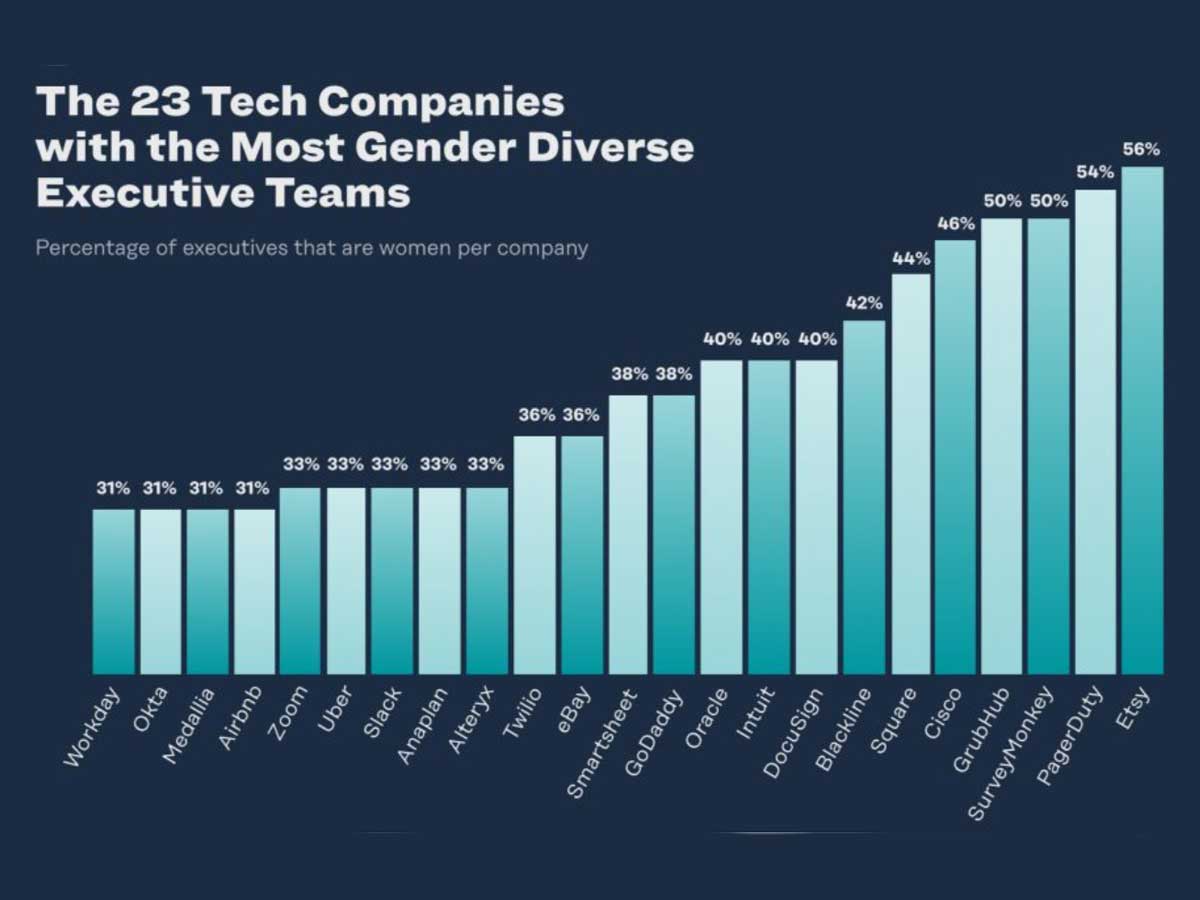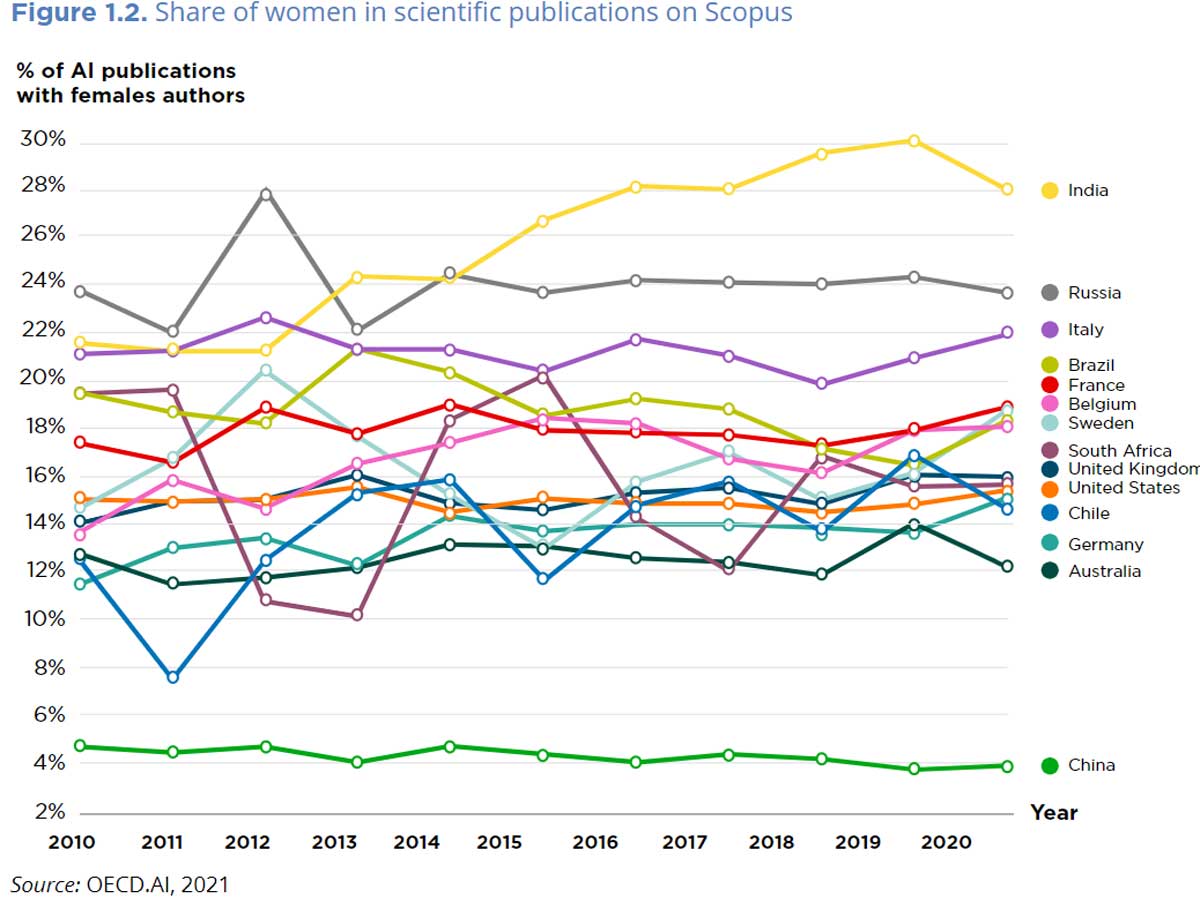It’s pretty clear from global studies that there’s a real issue in the workplace when it comes to women. They’re not only getting paid less than men, but they’re also not making it as often to those big senior positions.
Women are really underrepresented there. I came across this 2019 UNESCO report that put things into perspective: only 29% of the folks in science R&D are women. And guess what? Women are 25% less likely to be up to speed with using digital technology for even the simple stuff.
The global artificial intelligence market is steeply climbing, expected to skyrocket at a CAGR of 37.3% from 2023 to 2030, hitting an impressive $1,811.8 billion by the decade’s end.


But here’s an interesting thing: as of 2023, women are making their mark, though there’s still room to grow. They currently stand at 14% of the cloud computing workforce. In engineering, women are slowly inching up, holding 20% of the jobs. It gets better in data and AI, where they have a 32% slice of the pie.
But where the ladies shine is in Virtual Reality (VR) projects, leading the pack with a solid 33%. Augmented Reality (AR) projects and games are just a little behind, boasting 28% female involvement.


However, there’s a dip in backend services and web application projects, where women coders make up just 13% and 16%, respectively. Now, with Artificial Intelligence (AI) becoming a big deal, it makes you wonder about the future of women in the workforce.
Are we using AI to help close those gender equality gaps, or are we just letting them get worse? These are some serious questions we need to think about, especially with how fast AI is moving forward.
Potential Threat to 80% of Female Jobs from AI Automation & Generative AI
With Generative AI shaking things up, there’s a real buzz about how it might hit jobs hard. Think about this: a Goldman Sachs report is talking about a whopping 300 million jobs in the US and Europe, possibly getting swept up by AI automation.
Now, let’s talk about the job market and gender distribution. Women might be in a tighter spot with AI on the rise. Mark McNeilly from Kenan-Flagler School points out that many women work in white-collar jobs, which are right in the crosshairs of AI disruption.
In fact, about 79% of working women are in fields that AI might shake up. Jobs like office administrative support, where women are the majority, are particularly in the hot seat.


And industries like healthcare, education, and community and social services – all heavy with female workers – are looking at some big changes thanks to AI.
AI’s got a silver lining – it’s opening doors to new jobs that we haven’t even considered. Remember how machines in the past made some jobs obsolete but then created new ones?
It’s the same deal here. Plus, AI could take the yawn out of repetitive tasks, making jobs more interesting and efficient. Especially in healthcare, where many women work, AI could be a game changer, handling routine stuff like patient questions and leaving more time for the real human touch.
According to Mark McNeilly, it’s all about getting savvy with AI. Learning to work with this tech could set you apart in the job market.
Women in AI – Challanges


Global studies are pretty eye-opening about how women in AI-related jobs are few and far between. This isn’t just a numbers game; it’s about AI systems’ future. Without diverse minds behind them, these systems might miss the mark in serving everyone fairly.
At 15, only 0.5% of girls in OECD countries dream of becoming ICT professionals, way behind the 5% of boys. And in STEM, twice as many boys as girls see themselves as future engineers or scientists.
UNESCO reports that women hold a mere 29.3% of global science R&D jobs. Even in fields where innovation is key, like in Southwest Asia, East Asia, and the Pacific, the figures are super low. And it’s not just about having a job. In the EU, women’s enrollment in ICT studies is actually dropping.
Then, look at the big picture: only 7% of ICT patents in G20 countries are by women. And at major AI conferences, women speakers? Just 18%. The imbalance is stark in the software world, too, where women often get sidelined.
Even in Latin American countries, known for being a bit more balanced, the best we see is 34% female participation in AI publications.
So, what’s the fix? We’ve got to get more women into AI, data science, and software engineering. It’s not just about fairness; it’s about making AI as smart and unbiased as possible.
Algorithmic transparency


Talking about algorithmic transparency in AI systems, it’s a real mixed bag of challenges and chances. First off, we’re flying blind with little publicly available information.
This equivocation makes it tough to nail down algorithmic biases and embedded discrimination.
There’s a silver lining. Tech firms can step up their game by being clear about their AI, which is great for everyone – users, researchers, you name it. This clarity can help shape policies that are kinder to women, whether at work, home, or society.
More transparency equals better understanding and policies and maybe even a boost in women’s digital and AI skills.
UNESCO in May 2021, setting out 26 solid principles for internet companies to be more open. These rules aim to make firms more accountable, safeguard human rights online, and strengthen privacy and freedom of speech. And the OECD is on the same page, pushing for transparency in their AI Principles.
Artificial Intelligence and Workplace Harassment Targeting Women


It’s a tough scene for women dealing with harassment in online environments, especially when it ties into their jobs. In the United States, it’s startling that 33% of women under 35 face online sexual harassment, a number that’s three times higher than what men experience.
Over in the United Kingdom, the situation isn’t much better, with over half of the women, and 63% of those aged 18-24, enduring sexual harassment at work.
The rise of online work has only upped the ante, exposing women to more harassment threats. We’re talking about everything from nasty messages to the circulation of AI-manipulated images that can wreck careers.
For instance, Deeptrace’s 2019 study showed a shocking spike in deepfake videos, mostly targeting women. And women journalists? They’re caught in a tough spot, needing social media for their jobs yet facing constant online attacks.


But there’s some hope on the horizon, thanks to tech solutions like #MeTooMaastricht and #MeTooBots by NexLP, aiming to flag workplace harassment.
Then there’s Gfycat and Think Eva in Brazil, using AI to sniff out harassers. Even ELSA in Latin America is stepping up, using big data to shield women at work.
It’s clear that both tech innovations and legal moves, like the Online Safety Bill in the UK or the Violence Against Women Reauthorization Act in the US, are crucial.
Bradesco Inteligencia Artificial Against Harassment
Bradesco, a major player in Brazil’s banking scene since 1943, really stepped up its game in 2018 by introducing BIA (Bradesco Inteligência Artificial), an AI-powered chatbot.
It’s not just any chatbot; BIA is like a virtual assistant interacting across Google Assistant, WhatsApp, and even Alexa, making life easier for its 72 million customers.
But here’s the twist: in 2020, BIA got bombarded with 95,000 offensive messages, shedding light on a darker side of tech interactions.
Not one to stand by, Bradesco, in partnership with UNESCO, kicked off the BIA Against Harassment campaign in 2021. They weren’t just tweaking responses; they were taking a stand against gender-based Harassment.
Following cues from UNESCO’s “I’d Blush If I Could” report, BIA started clapping back with firm replies to any offensive jabs, challenging the norm of submissive virtual assistants.
The impact was huge. Bradesco’s bold move, part of the Hey, Update My Voice campaign, wasn’t just about reprogramming a chatbot. It was a call to action against the ingrained biases in tech.
Their campaign, complete with a viral video and engaging webinars, didn’t just reach a few; it hit home for over 115 million people, with 194 million YouTube views.
BIA Against Harassment became more than a campaign; it turned into a powerful statement on the widespread issue of Harassment and gender violence, resonating both online and offline.
Artificial Intelligence (AI) technologies are set to shake things up for women’s work opportunities, status, and how they’re treated at work. It’s a big deal, and this report digs into how AI will change the skills needed, how women hunt for jobs, and even how jobs are structured.
We’re talking automated monitoring and all. But here’s the thing: we don’t know how AI technologies will impact women at work yet.
We know that when we’re building and rolling out AI, we’ve got to be smart about it. We can’t let today’s gender stereotypes sneak into tomorrow’s tech. And it’s not just a tech thing – governments, industry, academia, and civil society all need to get on board.


They should work together, aiming for transparency and ensuring AI doesn’t repeat the same old gender biases.
Much research is still needed, especially around AI’s design, how it works, and its impact on society and culture. And let’s not forget: AI research is mostly happening in the Global North, so we’ve got to watch out for unintentional biases that could widen global inequalities.
For real change, women need equal chances to grab the resources, training, and skills they need for the future.
That means access to education and learning new skills for the jobs ahead. We’ve got to keep pushing for more women in STEM and AI – that’s key to closing these gender gaps.
Looking ahead, jobs will be all about connectivity and data access, especially in our digital, AI-driven world. But there’s a gap right now – women aren’t getting the same access to digital tools as men.
That’s something we’ve got to fix. We need to empower women to use AI and tech and be the ones calling the shots, managing and implementing these systems.


